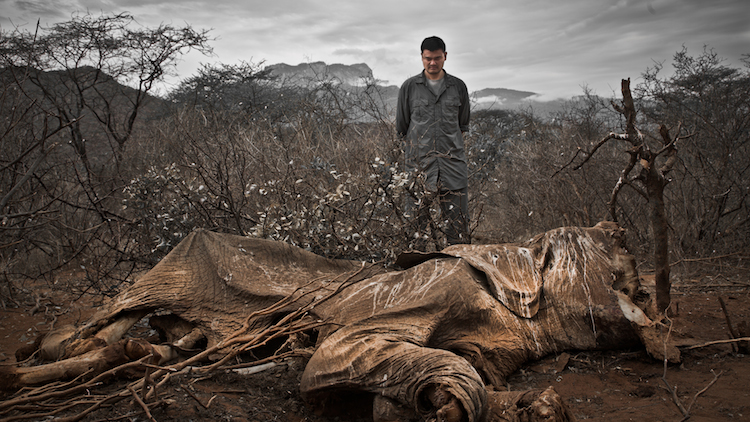On January 6, representatives from international governments and conservation organizations gathered in Dongguan, Guangdong, to witness an historic first. A display of ornate ivory carvings of all shapes and sizes and a heap of elephant tusks were fed into grinders. Six tons were destroyed, worth over US$10 million. The ivory had been seized from shipments from Africa and stores across China. The amount crushed equaled an estimated 600 slaughtered elephants.
“We were encouraged by the attitude, it was a big moment for us,” says May Mei, Chief Representative of WildAid China. “It was great timing and it shows the government is taking initiative,” she explains.
WildAid was especially encouraged by the timing of the crush, as it occurred not long after the launch of their anti-ivory campaign. The joint effort, involving charities African Wildlife Foundation (AWF) and Save the Elephants, has basketball superstar Yao Ming on board and specifically targets mainland Chinese consumers. “Surveys conducted in China indicate that a large percentage of the Chinese public is not aware of the elephant poaching crisis in Africa and do not connect buying ivory with this crisis,” says AWF spokesperson Kathleen Garrigan.
China’s surprising ivory crush followed on the heels of several other countries that demolished their accumulated stockpiles last year. The first Asian country to do so, the Philippines, destroyed their entire stock, after citing storage as one of the driving factors – the warehouse was frequently robbed. The US also eliminated their stockpile, as did Gabon.
While the PRC’s move to follow suit was applauded, it was unexpected – after all, China is the world’s largest consumer of ivory. And with economic growth increasing disposable incomes, the demand for ivory has not slowed. In fact, last year the market grew by 10 percent.
Destruction of ivory stockpiles is one of the most significant and symbolic acts in wildlife conservation. The first (and most dramatic) endeavor of this kind took place in 1989, when Kenyan president Daniel arap Moi and paleoanthropologist Richard Leakey set fire to 12 tons of ivory. It sent shockwaves around the world, as it essentially equated to burning cash that could have been used by the government. But it was a powerful demonstration of Kenya’s stance that the global ivory trade be abolished. One year later, the Convention on International Trade in Endangered Species (CITES) banned ivory imports. Results were noticeable – the declining elephant population was in recovery up until 2008.
Despite the ban, a survey conducted by the Elephant Trade Information System from 1990 to 2008 showed the seizures of tusks and carved ivory en route to China were the highest in the world, concluding that “China remains the most important contemporary player in the illicit trade in ivory.”
In a decision that conservationists have described as disastrous, CITES permitted one-off sales of legal ivory in auctions held in Namibia, South Africa and Botswana in November 2008. CITES allowed the sales, as the Chinese government had introduced new legislative measures to control the market. Chinese traders bought 62 of the 115 tons up for grabs, with the remainder going to Japan.
Since 2004, the market has increased 50 percent due to illegal imports, but also because of how it has been stimulated by the 62 tons of legal ivory. Although it is sold to the 33 government-designated carving factories, on-site surveys and interviews by the journal Pachyderm revealed that what factory managers were legally allowed to buy in no way met demand.

So where is the demand in China coming from? There is a long history and culture of ivory carving in China. Popular items include intricate scenes carved out of whole tusks and ‘magic balls,’ interlocking spheres com-monly used in feng shui. WildAid has tried to be sensitive to this. Representatives have been on antique shows on Chinese television to explain the difference between legal and illegal ivory.
In addition, Mei acknowledges that ivory is “very important in Buddhism,” and that opponents of the ivory crush often focus on the belief that it is wrong to destroy the ubiquitous statues of Buddha or Guanyin. In October 2012, National Geographic investigated the use of ivory in religion and found it was a driving force in the trade – and not just because of Buddhists. Ivory statues of Jesus and ivory Muslim prayer beads found around the world also contribute to the market.
However, the “disconnect” is pinpointed by Mei as being at the heart of the matter. In a WildAid survey, it was found most Chinese people “think ivory comes from natural death. They didn’t have a chance to have the correct information,” she says. Once reality was explained to survey participants, “95 percent said they believed ivory should be banned. We were surprised at the support. But it’s the 5 percent who are the buyers.” With this in mind, the campaign was designed with a slightly different approach. “They tend to come from Zhejiang, Shaanxi or Guangdong provinces, as that’s where the most wealth is located. We have placed billboards in high-end malls in Shanghai, for example, to target this group,” explains Mei.

Actors Li Bingbing and Edward Norton have joined the cause and new PSAs are running with Prince William and David Beckham. The goal of the campaign is to contribute to the “ultimate goal of a total ban,” Mei says firmly. Focusing on demand is crucial. According to Garrigan, when it “dries up, the ivory market will collapse and poaching that is motivated by ivory demand will stop.”
Xi Jinping’s ban on expensive government gift-giving practices and consumption of luxury products may also make a dent in the trade. Ivory is viewed as an “expensive product for bribery; it is often given by VIPs to curry favor,” says Mei. The ripple effect of Xi’s ban was seen as part of the impetus, alongside WildAid China’s successful Finished with Fins campaign – also lead by Yao Ming – to end shark fin soup consumption. The impact was tangible and impressive; sales declined 40 percent.
Garrigan agrees that it is money, but also incorrect information that contributes to the problem. “As a conspicuous luxury product, ivory consumption may in part be driven by the idea that people feel the need to show that they are as wealthy as their neighbors,” she says. “The demand is there because people don’t associate their ivory bracelet or carving with a poached elephant. Once they know what’s happening, it’s our belief that they’ll feel very differently.”
While the outlook for elephants may seem grim, those involved in the fight were buoyed by the initiative in Dongguan, hoping that it may portend a shift in the Chinese government’s commitment to ending the trade in blood ivory. Garrigan recognizes “how extremely important it was for raising awareness about wildlife trafficking. The fact that the event was covered and broadcast by CCTV is huge.” In the days after the Chinese crush, an unforeseen upshot occurred: the topic was re-opened in Hong Kong, a vital player in the illegal trade. If Hong Kong does follow through and destroy their 33-ton national stockpile, it would be the largest crush in history.
“Education is everything,” says Garrigan, re-emphasizing how highlighting the connection between ivory and poaching is key to continuing the momentum. “The more people know, the less likely they will want to buy ivory, even legal ivory, and they will come to value a live elephant more than a dead one. This happened in the United States and around the world in the late 1980s, when there was an international outcry over elephant poaching and ivory trade. There’s no reason to believe China’s citizens won’t respond in the same way.”






















0 User Comments